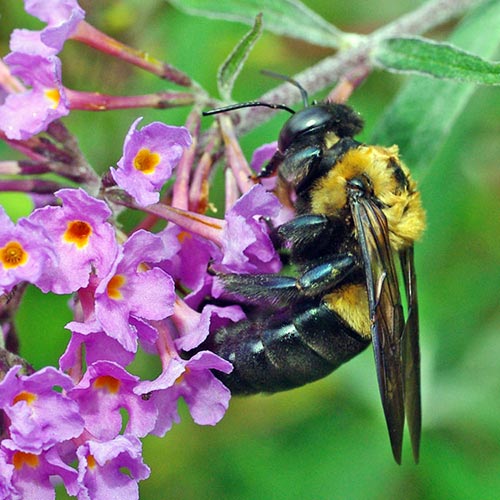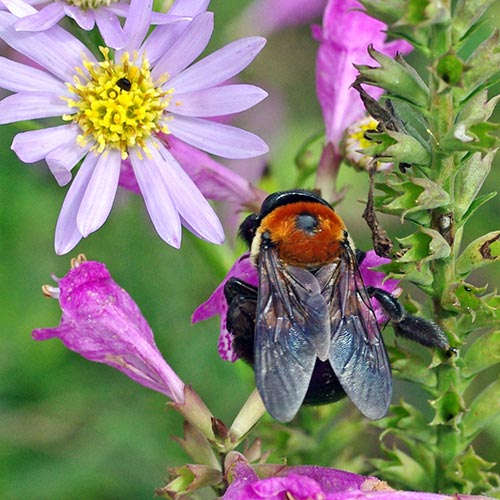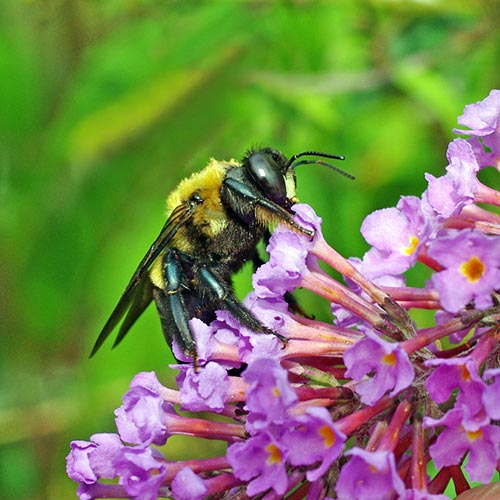Howdy, BugFans,
Back in the early ‘70’s, the BugLady worked at the Schuylkill Valley Nature Center in Philadelphia. She lived on the third floor of a big old house—a metal fire escape, left over from the house’s mid-life stint as a sanatorium, provided her access through a modified kitchen window. The house had a widow’s walk above the attic so that the original owner’s wife could use a spyglass to see if her husband’s ship was in the harbor. The BugLady often sat up on the widow’s walk to commune at eye level with local Turkey Vultures and to visit the carpenter bees that excavated the railings of the widow’s walk (in retrospect, it’s a good thing the BugLady didn’t lean against the railings).
Eastern Carpenter Bee
Eastern carpenter bees (Xylocopa virginica) (xylocopus is from the Greek for woodcutter) would fly up and hover in the air, bobbing back and forth, staring at the intruder. Yes, they do look like bumblebees, and at about 1” long, ECBs are the size of some of our larger bumblebee species. A carpenter bee’s rear is shiny and smooth (bumblebees have a hairy posterior), but its hind legs are densely hairy. Carpenter bees have big eyes, males more so than females (all the better to see you with, my dear), and compared to bumblebees, female ECBs have a large-headed look. Males sport a smooth, light/white patch on their face. Carpenter bees are strong, if noisy and clumsy, flyers. About a quarter of the ECBs the BugLady was photographing had a cinnamon-colored thorax.

ECBs are (now) classified in the family Apidae (some field guides place them in Anthophoridae), the same family as bumble, honey, and digger bees. There are about 500 species worldwide, but not all are plus-sized insects. ECBs are the most common carpenter bee species this side of the Mississippi, where they’re found in forests, grasslands, parks and gardens. There they fed on pollen and nectar from a wide variety of flat-ish flowers and as a result are considered valuable native pollinators in a world where pollinator populations are shrinking. Sometimes they cheat. Carpenter bees are medium-tongued bees (bumblebees have long tongues). If a flower is too deep and their tongue isn’t long enough they’ll do an end run, tunneling into the flower from the outside to harvest the nectar, by-passing the pollen and leaving a hole that other insects take advantage of.

Carpenter bees are famous for inventing particle board—a feat that doesn’t seem as awesome when the particles are from your redwood decks and railings. Their carpentry is tied to their reproductive behavior. In early summer, females make nests in seasoned wood like buildings, decks, and old, bark-free stumps. Carpenter bees are not social insects, though some species tolerate other nests close by (bumblebees typically nest in the ground and are social, with a queen maintaining a nest of workers throughout the warm months). Once a female stakes a claim on it, the wood will house carpenter bees all year.
A female ECB excavates a half-inch wide hole in wood. She prefers to use/extend the nest she hatched out in, so over the generations, the bees may leave wood decidedly honey-combed. One source says that she vibrates her body while rasping with her mandibles. When she’s about an inch into the wood, she makes a right turn and excavates with the grain for maybe six inches more, creating a gallery. It’s hard work—it takes almost a week to dig out an inch.
A single entrance leads to individual chambers, from six to twenty or so of them. When the chambers are prepared, Mom packs in an irregularly-shaped loaf of “bee-bread” made of the pollen and nectar she has collected. Pound for pound, carpenter bees lay some of the biggest eggs in insect-dom. She combines the sawdust from her efforts (you can locate holes by looking for small piles of sawdust) with saliva to make “particle board” partitions. This energy-intensive exercise has a price, the female dies soon after providing for the next generation.
When the egg hatches, the larva eats the bee bread and pupates within its chamber. It emerges as an adult in late summer, feeds for a while, and then retires to its natal nest for the winter. Males wake up first in spring, and the cycle restarts.
Big-eyed CBs like the ECB find their mates visually while flying and hovering and guarding flowers and nesting areas in hopes that a female will appear (smaller species of CBs use pheromones). The ECB on the widow’s walk was undoubtedly a curious male. Males are harmless—no stinger—and you have to work pretty hard to get stung by the non-aggressive females, but they will oblige eventually. There are reports of males making romantic overtures to other insects and even small birds, and males will try to escort interlopers out of their space. If you find their scrutiny unsettling, males can apparently be distracted by tossing a small object past them.

ECBs are a hot topic at Exterminators’ websites. Some non-exterminator sources insist that the damage is minor and is primarily superficial—close to the surface of your porch rails or siding (others concede damage, but say that it may take decades for that damage to become serious). Larger and more upsetting excavations may be made by woodpeckers, Mother Nature’s Exterminators, looking for a meal. There are mechanical and chemical controls for ECBs, and you can also “redirect” them by putting out some wood especially for them.
Try these bugguide.net links for some nifty shots of ECBs hovering and working with wood.
The BugLady